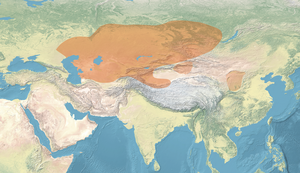General location of the Pazyryk culture within the Saka realm ( ), and contemporary Asian polities c. 325 BC | |
| Geographical range | South Siberia |
|---|---|
| Dates | 6th to 3rd centuries BC |
| Preceded by | Arzhan culture, Karakol culture |
| Followed by | Xiongnu, Tashtyk culture, Bulan-Koba culture |
The Pazyryk culture (Russian: Пазырыкская культура Pazyrykskaya kul'tura) is a Saka (Central Asian Scythian)[1] nomadic Iron Age archaeological culture (6th to 3rd centuries BC) identified by excavated artifacts and mummified humans found in the Siberian permafrost, in the Altay Mountains, Kazakhstan and Mongolia. The mummies are buried in long barrows (or kurgans) similar to the tomb mounds of Scythian culture in Ukraine. The type site are the Pazyryk burials of the Ukok Plateau.[2] Many artifacts and human remains have been found at this location, including the Siberian Ice Princess, indicating a flourishing culture at this location that benefited from the many trade routes and caravans of merchants passing through the area.[3] The Pazyryk are considered to have had a war-like life.[4] The Pazyryk culture was preceded by the "Arzhan culture" (Initial Scythian period, 8th - 7th century BC).[5]
- ^ The Editors (11 September 2001). "Pazyryk | archaeological site, Kazakhstan". Britannica.com. Retrieved 5 March 2019.
{{cite web}}:|author=has generic name (help) - ^ (NOVA 2007)
- ^ (State Hermitage Museum 2007)
- ^ (Jordana 2009)
- ^ Murphy, Eileen M. (2003). "Iron Age Archaeology and Trauma from Aymyrlyg South Siberia: An examination of the health diet and lifestyles of the two Iron Age populations buried at the cemetery complex of Aymyrlyg". BAR International Series.

